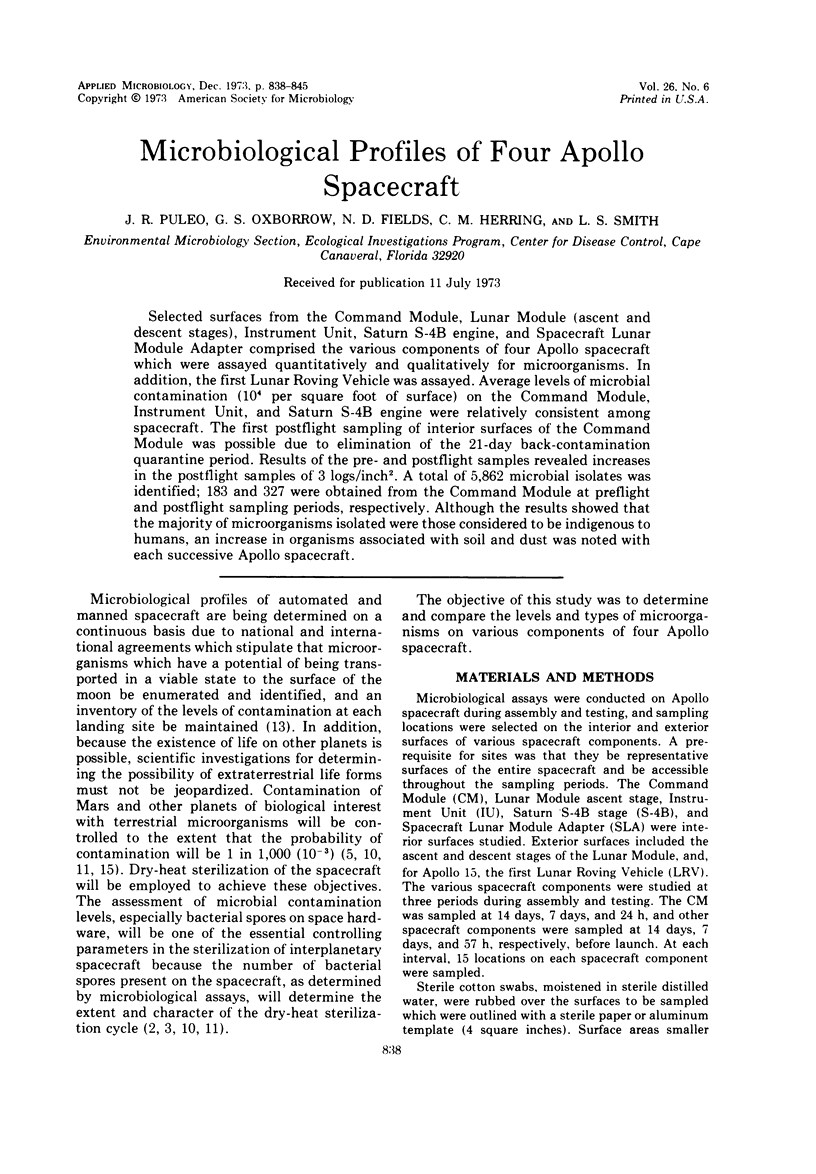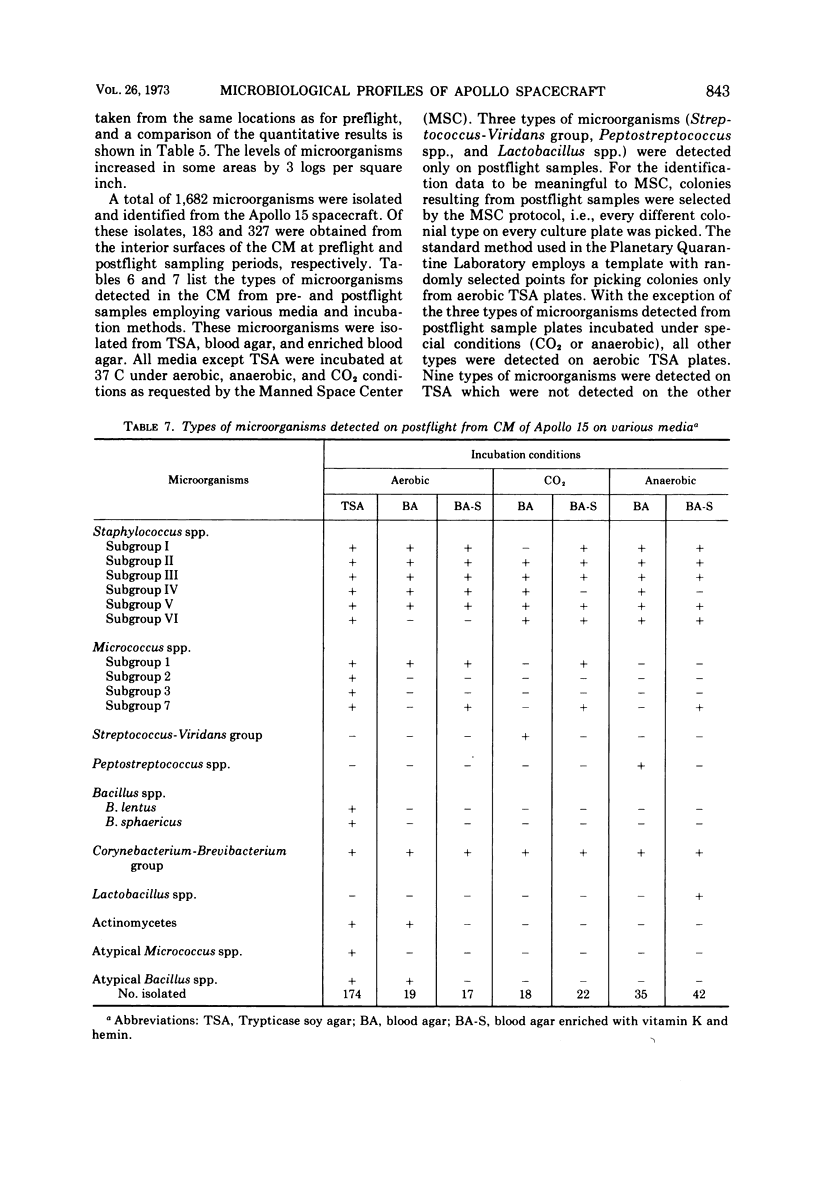Abstract
Selected surfaces from the Command Module, Lunar Module (ascent and descent stages), Instrument Unit, Saturn S-4B engine, and Spacecraft Lunar Module Adapter comprised the various components of four Apollo spacecraft which were assayed quantitatively and qualitatively for microorganisms. In addition, the first Lunar Roving Vehicle was assayed. Average levels of microbial contamination (104 per square foot of surface) on the Command Module, Instrument Unit, and Saturn S-4B engine were relatively consistent among spacecraft. The first postflight sampling of interior surfaces of the Command Module was possible due to elimination of the 21-day back-contamination quarantine period. Results of the pre- and postflight samples revealed increases in the postflight samples of 3 logs/inch2. A total of 5,862 microbial isolates was identified; 183 and 327 were obtained from the Command Module at preflight and postflight sampling periods, respectively. Although the results showed that the majority of microorganisms isolated were those considered to be indigenous to humans, an increase in organisms associated with soil and dust was noted with each successive Apollo spacecraft.
Full text
PDF







Selected References
These references are in PubMed. This may not be the complete list of references from this article.
- Bond W. W., Favero M. S., Petersen N. J., Marshall J. H. Dry-heat inactivation kinetics of naturally occurring spore populations. Appl Microbiol. 1970 Oct;20(4):573–578. doi: 10.1128/am.20.4.573-578.1970. [DOI] [PMC free article] [PubMed] [Google Scholar]
- Bond W. W., Favero M. S., Petersen N. J., Marshall J. H. Relative frequency distribution of d(125 C) values for spore isolates from the mariner-Mars 1969 spacecraft. Appl Microbiol. 1971 May;21(5):832–836. doi: 10.1128/am.21.5.832-836.1971. [DOI] [PMC free article] [PubMed] [Google Scholar]
- Favero M. S., Berquist K. R. Use of laminar air-flow equipment in microbiology. Appl Microbiol. 1968 Jan;16(1):182–183. doi: 10.1128/am.16.1.182-183.1968. [DOI] [PMC free article] [PubMed] [Google Scholar]
- Favero M. S. Microbiologic assay of space hardware. Environ Biol Med. 1971 May;1(1):27–36. [PubMed] [Google Scholar]
- Favero M. S., Puleo J. R., Marshall J. H., Oxborrow G. S. Comparative levels and types of microbial contamination detected in industrial clean rooms. Appl Microbiol. 1966 Jul;14(4):539–551. doi: 10.1128/am.14.4.539-551.1966. [DOI] [PMC free article] [PubMed] [Google Scholar]
- Hall L. B., Bruch C. W. Procedures necessary for the prevention of planetary contamination. Life Sci Space Res. 1965;3:48–62. [PubMed] [Google Scholar]
- Puleo J. R., Favero M. S., Petersen N. J. Use of ultrasonic energy in assessing microbial contamination on surfaces. Appl Microbiol. 1967 Nov;15(6):1345–1351. doi: 10.1128/am.15.6.1345-1351.1967. [DOI] [PMC free article] [PubMed] [Google Scholar]
- Puleo J. R., Favero M. S., Tritz G. J. Feasibility of using ultrasonics for removing viable microorganisms from surfaces. Contam Control. 1967 Apr;6(4):58–passim. [PubMed] [Google Scholar]
- Puleo J. R., Fields N. D., Moore B., Graves R. C. Microbial contamination associated with the Apollo 6 spacecraft during final assembly and testing. Space Life Sci. 1970 May;2(1):48–56. doi: 10.1007/BF00928955. [DOI] [PubMed] [Google Scholar]
- Puleo J. R., Oxborrow G. S., Fields N. D., Hall H. E. Quantitative and qualitative microbiological profiles of the Apollo 10 and 11 spacecraft. Appl Microbiol. 1970 Sep;20(3):384–389. doi: 10.1128/am.20.3.384-389.1970. [DOI] [PMC free article] [PubMed] [Google Scholar]


